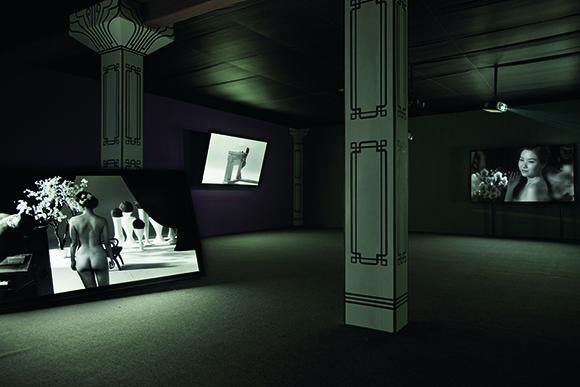YANG FUDONG: NEW WOMEN
| June 30, 2014 | Post In LEAP 27

Five-channel video installation, black-and-white film transferred to HD, 8-10 min.
Yang Fudong’s New Women premiered at a special exhibition during the 2013 Toronto International Film Festival. Shown in black and white on five screens arranged in a row on one gallery wall, New Women stood in contrast to its surroundings, an intense installation by Christopher Doyle called Away with Words. One of the most important screenings at “A Century of Chinese Cinema,” a concurrent exhibition at the festival, was a 1935 Cai Chusheng film also titled New Women. Yang Fudong’s film is his homage to Cai and other early Chinese filmmakers.
Visitors to the film’s presentation at ShanghART H-Space find themselves in a seductively pink-walled gallery, about which five screens are strewn at various heights. Yang Fudong chose actresses from Shanghai, Hong Kong, and Sydney to appear in the film wearing only make-up and jewelry. In the flickering light of the projections, one can discern the distinctly Western ornamental patterns on the two pillars in the middle of the gallery. On the screens, female figures stroll amid abstract versions of Greek or Roman ruins, listen to music in a Chinese-style courtyard, or recline on a rotating round platform. They stare at a fountain or gaze at one another, gently caressing each other on ornate antique furniture or looking up from a book in bed. Here, the plaster busts and famous canvases Yang encountered during his early study of oil painting become abstract props and settings. Returning to the female form, Yang’s images have long since bidden farewell to the brush in favor of an in-depth study in time.
The gentle movements and postures of the female form are a reflection and contemplation of the rhythm produced by the music, actors, and scenes of silent films, but they are also an attempt to extrapolate the “New Woman” concept of pre-1980s China into present notions of body, society, and image. The entanglements between Ruan Lingyu’s aggregated femininity and the masculinity imposed upon her by the times she lived in are re-imagined here within the post-realist circumstances of contemporary China. In order to conjure Cai Chusheng’s attempt to address the question of femininity on film, Yang chooses to adopt a completely non-verbal (and nude) aesthetic that harkens to the silent film era. The magnified bodies seem leisurely and carefree, but they also exert a certain pressure on the viewers standing amid them.
In fact, their contrived environment provides these women with an unusual liberation, the price of which is their complete separation from any ready-made narrative: solely images, they lack context. The scattered positions of the screens in the gallery prevent viewers from seeing everything at once, forcing them to focus on a part of the whole in which only the constant interference of light from the other screens provides a reminder of their presence. If a comparison must be made, then we can borrow the terms of Rancière’s distinction between the semiotician and the critical theorist (such as Barthes): Cai Chusheng’s New Women are “images that compose a certain narrative discourse” whereas Yang’s are “images that function as direct perceptions.” The former can transcend its era to impact the majority of viewers without disgracing the mission of the director and actors, whereas the latter seeks to juxtapose great images from history with paltry contemporary images, reconstituting a story that cannot be told.
This exhibition calls to mind About the Unknown Girl – Ma Sise, a project that Yang Fudong began in 2013. Although that film has already been shown at the Biennale de Lyon and BAM in New York, Yang himself states that he does not know when he will finish it. In the project, Yang attempts an earnest portrayal of the story of Ma Sise, an actress who has appeared in a number of Yang’s films, beginning with General’s Smile (2008). If she is not one of the roles she plays, nor the unity of her various specious images, then who might she be? One possibility is that she will appear in New Women II. And compared to New Women II, the fabricated reality or real fabrication of Ma is indeed something that can only be found where it is not sought.

